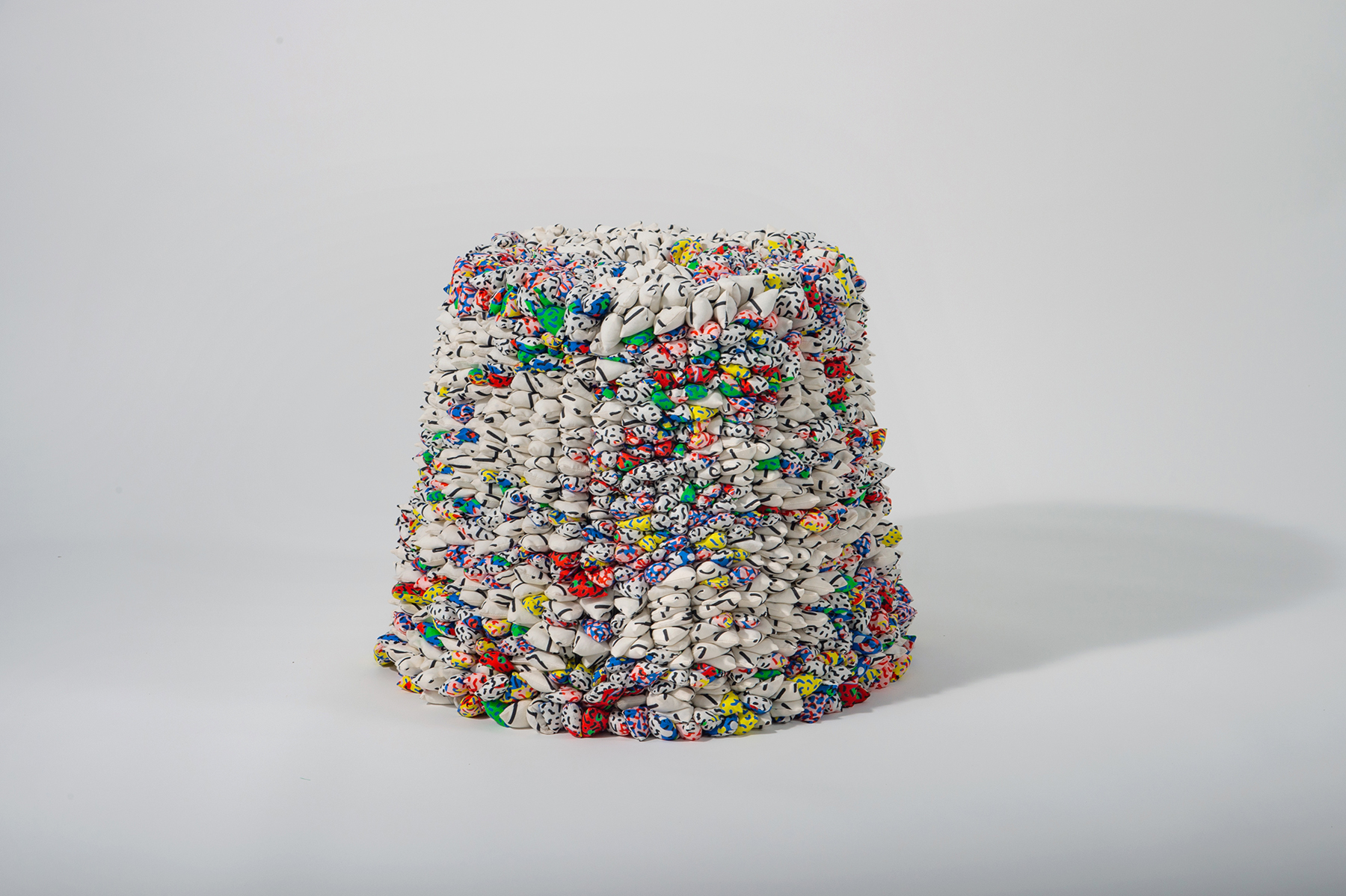
Scan our QR code to stay updated with the recent news and upcoming events.
2025.11.11- 2025.12.30
B1-6, Sunken Garden, Lane No.9, Qufu Lu, Jing An District Shanghai 200085
by Wu Shu
Laozi's insight, "what is, is for benefit; what is not, is for use", reveals the creative power inherent in emptiness itself. The winding paths of a Chinese garden exist not to shorten the journey but to deepen the experience; the blank spaces in ink-wash painting are not compositional conveniences but philosophical practice, treating white as black, allowing void to become the source of artistic conception. This understanding of emptiness unveils the essential order behind appearances.
European aesthetics shares this profound pursuit of the "useless." From ancient Greece's quest for pure rational harmony to Kant's "purposiveness without purpose," art's disinterestedness was firmly established. A Rococo ornament's value lies not in function but in its capacity to evoke resonance and aesthetic ecstasy; a Gothic cathedral's soaring spires, transcendent in their seemingly useless scale, ignite the sacred and awe. These are ultimate expressions of transcendental spiritual values. The Bauhaus principle "less is more" strips away redundancy to let material speak.
Contemporary society's predicament lies in the excessive inflation of the "useful." When everything becomes instrument and value becomes data, we lose connection with existence itself. Digital hyper-connectivity breeds unprecedented loneliness; material abundance masks spiritual impoverishment.
This exhibition explores how to fuse intangible philosophical contemplation into tangible spaces, objects, and experiences, creating a spiritual enclave for those trapped in efficiency's vortex, a place to breathe, reflect, and return to authenticity. The emptiness of Yu Mengtong's vessels, the transience of Yen Hsiao's flames, the discarded in Sabrina J's fabrics, the resonance in Liu Gang's bamboo and machinery, the generation in Tong Xindi and Shen Ting's algorithms, all remind us that profound utility resides in aesthetic experiences transcending utilitarian calculation.
Yu Mengtong uses ceramics to explore vessels' philosophical significance. She regards clay as life's carrier, "born of earth, returning to earth", investigating spatial relationships between interior and exterior through the vessel's boundaries. References to Shuowen Jiezi and natural imagery reveal the inclusiveness within a vessel's emptiness. As she notes, a "door" is unenclosed space, three sides bound, one open. This semi-open form perfectly metaphors the utility of uselessness: space designed for no specific function gains the greatest capacity to accommodate.
Sabrina J transforms fashion industry scraps into soft sculptures, giving forgotten materials new life through wrapping and rebirth. These works respond to sustainability while tenderly guarding memory and emotion. She liberates personal stories and era imprints from fashion's transient cycle, placing them into softer, more intimate, more eternal contexts, elevating "useless" waste into emotional vessels connecting past and future.
Yen Hsiao externalizes Zen meditation into inner practice, creating poetic dialogue between bronze's eternality and flame's ephemerality. Flickering lights become more than material symbiosis, they are spiritual vehicles guiding viewers into meditative states. The seemingly non-utilitarian creative process and non-functional artistic elements become the core force transmitting tranquility and evoking resonance.
Liu Gang disassembles and reassembles discarded industrial and electronic components, integrating them with sound and interactive installations, allowing technological "relics" to be reborn after losing practical value. In his bamboo lamps, hollowed sections become vessels for light, awakening bamboo's inner vitality. This approach blurs boundaries between useful and useless, revealing that overlooked objects contain the richest memories, emotions, and spiritual connotations. Electronic components become carriers of technological memory; light flowing between bamboo segments illuminates not only material essence but viewers' inner tranquility and resonance.
Tong Xindi and Shen Ting translate Turing's reaction-diffusion equation into ceramic art's generative logic through self-made machinery and programming. They capture nature's unconscious formations through digital control, yet surrender to the kiln's serendipity. Refined algorithms yield to flame's unpredictability; rigorous programs serve the freest expression. The algorithm's ultimate purpose is not efficiency or precise replication, but deeper understanding of nature's mechanisms, recreating, through dialogue between human and machine, control and chance, those vital forces transcending consciousness.
Each work invites us to step away from utilitarian clamor, to rediscover within art's uselessness the beauty efficiency obscures, to reclaim life's rightful poise and richness, to seek our time's spiritual home. There, profound utility hides within every useless moment we dare embrace. Let efficiency make room for poetry, function pay homage to emotion, technology serve humanity. This is not denial of practical value but quest for higher balance, where useful and useless nourish each other like yin and yang, weaving the complete tapestry of human existence.

Infinite blossom coffee table, Memphis pattern silk offcuts sewn on recycled structures, 45*45*45cm, 2023

Infinite blossom chair 01, Memphis pattern silk offcuts sewn on recycled structures, 57*86*58 cm, 2023
by Wu Shu
Laozi's insight, "what is, is for benefit; what is not, is for use", reveals the creative power inherent in emptiness itself. The winding paths of a Chinese garden exist not to shorten the journey but to deepen the experience; the blank spaces in ink-wash painting are not compositional conveniences but philosophical practice, treating white as black, allowing void to become the source of artistic conception. This understanding of emptiness unveils the essential order behind appearances.
European aesthetics shares this profound pursuit of the "useless." From ancient Greece's quest for pure rational harmony to Kant's "purposiveness without purpose," art's disinterestedness was firmly established. A Rococo ornament's value lies not in function but in its capacity to evoke resonance and aesthetic ecstasy; a Gothic cathedral's soaring spires, transcendent in their seemingly useless scale, ignite the sacred and awe. These are ultimate expressions of transcendental spiritual values. The Bauhaus principle "less is more" strips away redundancy to let material speak.
Contemporary society's predicament lies in the excessive inflation of the "useful." When everything becomes instrument and value becomes data, we lose connection with existence itself. Digital hyper-connectivity breeds unprecedented loneliness; material abundance masks spiritual impoverishment.
This exhibition explores how to fuse intangible philosophical contemplation into tangible spaces, objects, and experiences, creating a spiritual enclave for those trapped in efficiency's vortex, a place to breathe, reflect, and return to authenticity. The emptiness of Yu Mengtong's vessels, the transience of Yen Hsiao's flames, the discarded in Sabrina J's fabrics, the resonance in Liu Gang's bamboo and machinery, the generation in Tong Xindi and Shen Ting's algorithms, all remind us that profound utility resides in aesthetic experiences transcending utilitarian calculation.
Yu Mengtong uses ceramics to explore vessels' philosophical significance. She regards clay as life's carrier, "born of earth, returning to earth", investigating spatial relationships between interior and exterior through the vessel's boundaries. References to Shuowen Jiezi and natural imagery reveal the inclusiveness within a vessel's emptiness. As she notes, a "door" is unenclosed space, three sides bound, one open. This semi-open form perfectly metaphors the utility of uselessness: space designed for no specific function gains the greatest capacity to accommodate.
Sabrina J transforms fashion industry scraps into soft sculptures, giving forgotten materials new life through wrapping and rebirth. These works respond to sustainability while tenderly guarding memory and emotion. She liberates personal stories and era imprints from fashion's transient cycle, placing them into softer, more intimate, more eternal contexts, elevating "useless" waste into emotional vessels connecting past and future.
Yen Hsiao externalizes Zen meditation into inner practice, creating poetic dialogue between bronze's eternality and flame's ephemerality. Flickering lights become more than material symbiosis, they are spiritual vehicles guiding viewers into meditative states. The seemingly non-utilitarian creative process and non-functional artistic elements become the core force transmitting tranquility and evoking resonance.
Liu Gang disassembles and reassembles discarded industrial and electronic components, integrating them with sound and interactive installations, allowing technological "relics" to be reborn after losing practical value. In his bamboo lamps, hollowed sections become vessels for light, awakening bamboo's inner vitality. This approach blurs boundaries between useful and useless, revealing that overlooked objects contain the richest memories, emotions, and spiritual connotations. Electronic components become carriers of technological memory; light flowing between bamboo segments illuminates not only material essence but viewers' inner tranquility and resonance.
Tong Xindi and Shen Ting translate Turing's reaction-diffusion equation into ceramic art's generative logic through self-made machinery and programming. They capture nature's unconscious formations through digital control, yet surrender to the kiln's serendipity. Refined algorithms yield to flame's unpredictability; rigorous programs serve the freest expression. The algorithm's ultimate purpose is not efficiency or precise replication, but deeper understanding of nature's mechanisms, recreating, through dialogue between human and machine, control and chance, those vital forces transcending consciousness.
Each work invites us to step away from utilitarian clamor, to rediscover within art's uselessness the beauty efficiency obscures, to reclaim life's rightful poise and richness, to seek our time's spiritual home. There, profound utility hides within every useless moment we dare embrace. Let efficiency make room for poetry, function pay homage to emotion, technology serve humanity. This is not denial of practical value but quest for higher balance, where useful and useless nourish each other like yin and yang, weaving the complete tapestry of human existence.